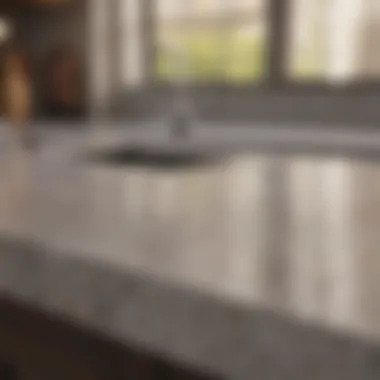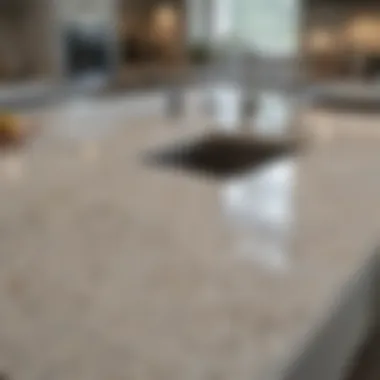Ultimate Guide to Removing Stains from Quartz Counters


Intro
Quartz countertops are renowned for their durability and aesthetic appeal, serving as a central feature in many kitchens and bathrooms. Despite their resilient nature, these surfaces can still fall victim to unsightly stains from various substances. Understanding how to effectively remove these stains will not only preserve the beauty of your countertops but also extend their lifespan. This guide aims to equip homeowners and interior design enthusiasts with the knowledge required for effective stain removal.
Stains can emerge from several sources, including food, beverages, and cleaning agents. Each type of stain may require a different approach, necessitating a well-informed strategy for successful removal. Addressing this topic is not only important for maintaining the surface's look, but also vital for ensuring a sanitary environment in shared spaces. Here, we aim to delve into the nuances of stain types, cleaning methods, and best practices for prevention, ensuring that your quartz countertops remain unblemished and vibrant.
Design Inspirations
Trending Styles
The design of a kitchen or bathroom can be significantly influenced by the choice of countertop material. Quartz countertops offer versatility, complementing various decor styles. From modern minimalism to traditional elegance, quartz can enhance the overall aesthetic. Popular styles include sleek white varieties or deep-colored options with intricate patterns. These choices allow homeowners to express personal tastes while maintaining functionality.
Color Palettes
Selecting the right color palette is crucial in achieving a cohesive look among kitchen or bathroom elements. Light tones such as soft whites, grays, and beiges tend to create an open, airy feel. Darker hues may offer a dramatic contrast, providing depth and sophistication. Pairing quartz with complementary cabinetry, backsplash, and flooring can have a significant impact on visual appeal.
Maintenance and Upkeep
While quartz countertops are relatively low-maintenance, regular care is still essential to prevent stains from settling. Understanding proper cleaning techniques not only restores the surface but also enhances its longevity.
Seasonal Maintenance Checklist
A seasonal maintenance checklist can help keep your quartz countertops in top shape. Consider incorporating the following tasks into your routine:
- Regularly wipe down countertops with a mild detergent to prevent buildup of dirt and grime.
- Inspect for any signs of damage or wear, addressing them promptly with effective cleaning solutions.
- Reseal the surface as recommended by manufacturers to ensure optimal protection against stains.
Cleaning and Organization Tips
Keeping countertops clean and organized can greatly minimize the chances of staining. Here are some actionable tips:
- Use cutting boards and trivets to protect the surface from heat and abrasive tools.
- Clean spills immediately, focusing on acidic substances like citrus or wine, which can cause discoloration.
- Organize frequently used items in a way that reduces clutter, making it easier to maintain surface cleanliness.
"By regularly maintaining your quartz countertops, you safeguard their beauty and functionality for years to come."
Prolusion to Quartz Countertops
Quartz countertops are increasingly popular in modern kitchens and bathrooms. The appeal lies in their aesthetic versatility and durability. Unlike natural stone, quartz surfaces are engineered, comprising about 90-95% crushed quartz crystals mixed with resins and pigments. This gives them a non-porous surface, making them less likely to absorb liquids compared to granite or marble.
One significant advantage of quartz countertops is their resistance to staining. They can withstand daily wear and tear from various substances commonly found in homes, such as food, beverages, and household chemicals. However, misunderstanding how to care for quartz can lead to unsightly stains.
Homeowners often choose quartz for its low maintenance requirements. Unlike natural stones, quartz does not require regular sealing. Nevertheless, it still needs proper cleaning and maintenance methods to uphold its visual appeal and resilience.
Understanding quartz countertops is essential for anyone looking to maintain their beauty and functionality. Proper care can extend the life of these surfaces, making them a worthwhile investment. This guide will aid homeowners and interior design enthusiasts in understanding how to effectively tackle and avoid stains, retaining the newness and shine of their quartz countertops.
Understanding Stains on Quartz
Understanding stains on quartz countertops is essential for effective maintenance. Quartz is a popular material due to its durability and aesthetic appeal. However, it is not immune to staining, and knowing the nature of these stains helps in choosing the right cleaning techniques to preserve the surface. Different stains originate from various sources, and some can be more challenging to remove than others. By familiarizing oneself with common types of stains, one can better prepare for necessary interventions to maintain the beauty of quartz.
Common Types of Stains
Stains can vary significantly based on their sources. Here are some key types that one might encounter:
Food-related stains
Food-related stains typically result from spills. They often include sauces, fruit juices, or wine. These stains stand out because they can penetrate the surface if not cleaned promptly. They are crucial to address since they can alter the appearance of the countertop. Food-related stains can be removed easily when cleaned quickly. The longer they sit, the harder they become to eliminate.
Chemical stains
Chemical stains arise from cleaning agents or other substances that react negatively with quartz. These stains are often identified by discoloration or dull spots. It's important to understand the specific residues that may lead to chemical staining. Using harsh chemicals can damage the surface, making it more prone to future stains. This highlights the need for cautious product selection.
Watermarks


Watermarks are another common issue. They usually appear after spills of water or other liquids. They can create an unsightly appearance, especially when left unmanaged. Their main feature is that they tend to be surface-level stains. Hence, they may often be removed with simple rinses or wipes. Failing to address watermarks can encourage more persistent stains over time.
Oil stains
Oil stains come from cooking oils or greasy foods. They are unique because they can seep deeper into the quartz. This makes them resistant to standard cleaning solutions. Oil stains generally require specialized methods to remove. Their characteristics emphasize the importance of immediate attention to spills, particularly in kitchens.
Identifying Stain Causes
Identifying the causes of stains helps prevent similar issues in the future. Several culprits include:
Everyday spills
Everyday spills are inevitable in kitchens and dining areas. These incidents range from dropping food to splashes when washing dishes. Given this frequent occurrence, recognizing how quickly to act on stains is invaluable. Developing a habit of immediate cleaning can prevent deeper issues later, saving time and effort in maintenance.
Improper cleaning products
Not all cleaning agents are suitable for quartz. Improper cleaning products can weaken the surface finish or react chemically, causing stains. Individuals should be aware of what products are safe to use on quartz. This approach minimizes the risk of unintentional damage while maintaining cleanliness.
Environmental factors
Environmental factors can influence how stains develop. Humidity levels, temperature variations, and exposure to sunlight all play roles in stain formation. Understanding these influences can lead to better care routines. Homeowners should consider these aspects when choosing countertops for specific environments.
Understanding the source of stains is half the battle. Preventing them requires more than just immediate cleanup; it's about knowing how to protect surfaces over time.
Preparation for Stain Removal
In order to effectively remove stains from quartz countertops, a thorough preparation stage is essential. This phase not only sets the groundwork for successful cleaning but also minimizes potential damage to the surface. Proper preparation includes gathering the right tools and supplies, understanding safety precautions, and being informed about the best practices for stain removal. Failing to prepare adequately can lead to ineffective cleaning and, at worse, damage to the countertops. By investing time in this preparation stage, homeowners can ensure a more efficient and successful stain removal process.
Gather Necessary Tools and Supplies
Having the right tools on hand is crucial. Here are key items you should consider:
Soft cloths
Soft cloths are an important accessory for the cleaning process. Their structure allows for gentle wiping, reducing the risk of scratching the quartz surface. A key characteristic of soft cloths is their ability to effectively absorb liquids. This makes them a beneficial choice as they prevent spreading the stain further while cleaning. Additionally, their non-abrasive nature helps preserve the finish of quartz countertops.
Mild dish soap
Mild dish soap serves as an effective cleaning agent due to its biodegradable properties. It is specifically designed to break down grease and food residues without being harsh on surfaces. Being gentle, it is ideal for quartz countertops, where stronger chemicals can lead to damage. This soap's unique formulation means it can cut through oily stains while remaining safe for daily use on delicate surfaces.
Baking soda
Baking soda is a versatile cleaning ingredient with great effectiveness in stain removal. This natural product acts as a gentle abrasive, helping to lift stubborn stains without causing scratches. Its key characteristic is its alkaline nature which allows it to neutralize acids, making it particularly useful for red wine or tomato stains. However, while effective, too much baking soda can lead to clouding if not diluted properly, thus requiring careful usage.
White vinegar
White vinegar is known for its acidic properties, which can dissolve tough stains. It works well against mineral deposits and can help eliminate odors. The key characteristic of white vinegar is its ability to break down sticky residues, making it a popular choice for maintaining cleanliness around the home. Despite its effectiveness, undiluted vinegar can be too harsh for quartz surfaces, so it is important to mix it with water in a solution for safe and effective use.
Safety Precautions
Working with cleaning supplies requires taking safety precautions to ensure well-being during the process. This not only protects the user but also prevents damage to the quartz countertops.
Wearing gloves
Wearing gloves is a simple yet effective measure to protect skin from irritants. Many cleaning agents, including some mild ones, can cause dryness or allergic reactions. A notable benefit of using gloves is maintaining cleanliness. This prevents oils and dirt from hands from transferring onto the countertop. In general, choosing reusable latex or nitrile gloves is advisable for this task.
Ensuring proper ventilation
Ensuring proper ventilation is crucial when cleaning with any products that emit fumes. Good air circulation helps reduce inhalation risk of potentially harmful substances. A key aspect of this safety precaution is the prevention of dizziness or discomfort while working. Open windows and using fans can help maintain airflow, which makes for a much safer cleaning environment, especially when using stronger cleaning solutions.
Step-by-Step Stain Removal Techniques


Removing stains from quartz countertops requires a structured approach. This section outlines methods that not only clean the surface but also ensure its longevity. Each technique focuses on specific cleaning strategies, emphasizing the importance of regular maintenance.
General Cleaning Method
Applying mild soap solution
Applying a mild soap solution to quartz countertops is a fundamental step in cleaning. It helps dissolve dirt and grime effectively. The key characteristic of using mild soap is its non-abrasive nature, which means it won't scratch the surface. This method is popular in this article due to its simplicity and accessibility.
Using a mild soap also ensures that no harmful chemicals interfere with the quartz finish. It is vital to choose a soap that is free of strong acids or abrasive materials. Its advantages include safety for the countertop's finish and the environment, making it a reliable choice. However, one must take care to rinse thoroughly as soap residue can attract dirt.
Wiping down the surface
Wiping down the surface after applying the mild soap is crucial for removing any lingering dirt. It ensures that all soap and contaminants are eliminated, leaving a clean countertop. The key characteristic of this step is its thoroughness; any missed areas can lead to buildup over time. This method is beneficial because it promotes not just cleanliness, but also hygiene.
This step requires a soft cloth to prevent damage while cleaning. The unique feature of wiping is that it allows for visual checks of the countertop. By observing the surface, one can identify areas that may need more attention. This method is very advantageous as it can prevent stains from embedding deeper into the quartz, thus prolonging the time between major cleanings.
Removing Specific Stains
Food stains
Food stains are a common issue in kitchen environments. These stains arise from spills such as sauces, juices, or other food substances. The primary characteristic of food stains is their ability to set quickly, making prompt attention necessary. Addressing food stains is crucial because they can alter the appearance of the countertop.
A beneficial aspect of tackling food stains is that many can be removed using household products like baking soda or a diluted vinegar solution. Their unique feature lies in their easy accessibility. While most food stains can be managed easily, some might require specific attention, like those from acidic foods which can etch the surface if left untreated for too long.
Oil stains
Oil stains can be particularly stubborn due to their thick consistency. They are often caused by cooking or food preparation incidents. The main characteristic of oil stains is their tendency to seep into the pores of the countertop. This makes the timely removal of oil stains essential to maintain the countertop’s aesthetic and functional qualities.
Using a paste made from baking soda and water can effectively lift oil stains. This method is advantageous because it avoids harsh chemicals that could damage the quartz surface. However, oil stains may require multiple applications to completely remove, which can be seen as a disadvantage for those seeking quick results.
Chemical stains
Chemical stains are often the result of exposure to harsh cleaning agents or spilled products like cleaners and solvents. The specific aspect of chemical stains is their potential to harm the finish of the quartz. This is why they are particularly concerning. Dealing with chemical stains effectively is vital to preserve the integrity of the countertop.
Using a gentle approach, such as wiping immediately with water or a soft cloth, can help neutralize these stains. The key characteristic of this method is its preventive nature. By acting quickly, one can avoid irreversible damage. The main disadvantage is that some chemical stains may linger, requiring specialized products designed for quartz surfaces to address them fully.
Important Note: Always test any cleaning method on a small, inconspicuous area before proceeding with the entire surface to avoid unintended damage.
Advanced Stain Treatment Methods
Dealing with tough stains on quartz countertops can sometimes require more than basic cleaning. Advanced stain treatment methods can provide effective solutions when standard cleaning does not suffice. Understanding these methods is important for maintaining the appearance and longevity of your countertops. If the common techniques have failed, using more specialized methods can restore your quartz surfaces and help prevent future issues.
Using Baking Soda Paste
Baking soda is a versatile and effective cleaning agent. It is gentle yet potent enough to break down stubborn stains without damaging the quartz. To use baking soda paste, mix baking soda with a little water to form a thick paste. Apply this paste directly to the stained area and let it sit for about 10 to 15 minutes. The alkalinity of baking soda works to lift stains, making them easier to wipe away.
After letting it sit, gently scrub the area with a soft cloth. This method is especially useful for food and oil stains. It is safe, inexpensive, and does not introduce harsh chemicals into your home environment. Moreover, baking soda is often found in most households, making it a readily available option.
Applying Commercial Cleaners
While home remedies can be effective, there are times when commercial cleaners become necessary. It’s crucial to choose these products wisely to avoid any damage to the quartz surface.
Choosing the right product
When selecting a commercial cleaner, it is important to pick one that is specifically designed for quartz surfaces. The key characteristic of such products is that they are formulated to clean without being abrasive. They contain ingredients that can tackle tough stains while being gentle on the surface.
One of the advantages of commercial cleaners is that they often come with additional benefit of disinfecting. This can be valuable, especially in kitchen areas where food is prepared. However, some products might contain harsh chemicals, which could pose risks if used improperly.
Following manufacturer instructions
After obtaining your commercial cleaner, it is essential to follow the manufacturer’s instructions closely. This ensures that you apply the product correctly and achieve the desired outcome. The key aspect here is that proper application can maximize the cleaner’s effectiveness while minimizing potential damage.


Most instructions will detail how long to let the cleaner sit, how to apply it, and how to rinse afterwards. The unique feature of adhering to manufacturer guidelines is that they are tested and proven for the product’s best use. Ignoring these instructions can lead to unsatisfactory results, making it a critical part of the stain removal process.
"Proper care and maintenance can significantly extend the life of quartz countertops."
Following these advanced methods enhances the longevity of your countertops and preserves their aesthetic appeal. By using baking soda paste for minor stains and commercial cleaners for tougher challenges, homeowners can effectively manage their quartz surfaces.
Ensuring the correct choice and following the instructions is advisable. This knowledge arms property owners with the means to keep their spaces looking pristine.
Preventive Measures to Avoid Future Stains
Preventing stains on quartz countertops is essential for maintaining their beauty and durability. Quartz surfaces, while generally resistant to staining, are still vulnerable to specific substances that can compromise their finish. Establishing effective preventive measures allows homeowners and design enthusiasts to enjoy their quartz countertops for many years with minimal maintenance. It is a proactive approach that saves time and effort in the long run, as dealing with stains after they occur can be time-consuming and may require special cleaning treatments.
Regular Cleaning Schedule
Implementing a regular cleaning schedule is crucial to prevent stains from forming on quartz countertops. Routine cleaning helps remove residues and prevents the build-up of substances that may lead to stains. A simple daily wipe down with a soft cloth and mild dish soap is an effective practice.
By adhering to a schedule, homeowners can catch spills and messes before they set in. Consider cleaning surfaces after each use, especially during food preparation. If quartz countertops are subjected to heavy use, a weekly deep clean can also be beneficial. Using products specifically designed for quartz will help in maintaining their luster and integrity without leading to deterioration.
Proper Use of Quartz Surfaces
Avoiding harsh chemicals
Using harsh chemicals on quartz can do more harm than good. Many cleaning products contain abrasive ingredients or strong acids that may scratch or dull the surface. Choosing gentle cleansers is not only safe but also prolongs the lifespan of the quartz.
Harsh chemicals can also lead to discoloration or damage over time. The key characteristic of avoiding these substances is promoting a safe cleaning environment. This practice is beneficial for both the aesthetic appeal of the quartz and the health of those who use the surfaces.
To maintain quartz effectively, consumer should focus on products that are labeled as pH-balanced or specifically formulated for stone surfaces. These alternatives offer sufficient cleaning power without risking damage.
Using cutting boards
Another effective preventive measure is the use of cutting boards while working in the kitchen. This method protects quartz countertops from cuts and scratches that can lead to staining.
Cutting boards are a simple yet valuable tool in maintaining the beauty of the quartz surface. Their primary function is to provide a safe area for food preparation, minimizing direct contact between sharp knives and quartz. By using cutting boards, one can significantly reduce the chances of accidental stains from food items.
Moreover, engaging with cutting boards made from wood or plastic can help absorb some moisture from spills, providing an additional barrier against liquid damage. This practice emphasizes thoughtful use of kitchen equipment to maintain cleanliness and prevent future issues with quartz surfaces.
Incorporating these preventive measures ensures that quartz countertops remain in optimal condition while enhancing their functionality. By being proactive, any potential staining can be easily avoided.
Dealing with Stubborn Stains
Addressing stubborn stains on quartz countertops is crucial for preserving not only the aesthetic appeal but also the functionality of these surfaces. Stains can arise from various sources, and when they become persistent, they can detract from the overall appearance of a kitchen or bathroom. Understanding how to identify and treat these stains is a valuable skill for homeowners and design enthusiasts alike. The steps taken to manage these challenging marks can save both time and money, preventing the need for expensive repairs or replacements.
When to Seek Professional Help
Stubborn stains may resist common cleaning methods. When basic techniques fail, it might be appropriate to consider hiring a professional. Professionals have specialized tools and solutions that can be more effective than household methods. For instance, they may use steam cleaning or professional-grade cleaning agents tailored for quartz. Additionally, their expertise can avoid damage that might occur from improper cleaning practices. If a stain has persisted despite numerous attempts, enlisting an expert might be the best action to take.
Long-term Maintenance Tips
Long-term maintenance is essential to prevent stubborn stains from becoming a recurring issue. Here are two key areas to focus on:
Sealing Quartz Countertops
Sealing quartz countertops plays an important role in protecting these surfaces from stains. When properly sealed, quartz can resist liquids better and provide a barrier against grime. A good seal enhances the durability of the countertop while also making it easier to clean. Regularly re-sealing the surface typically every six months to a year, depending on usage, can keep your countertops looking fresh. However, it is crucial to choose a high-quality sealant compatible with quartz to ensure maximum protection.
Periodic Inspections
Conducting periodic inspections allows homeowners to catch potential problems early. These checks can reveal minor issues before they become stubborn stains. A key feature of periodic inspections is that they encourage proactive care. For example, if you see discoloration starting to form, it is easier to address promptly rather than waiting until it sets in. Schedule these inspections at least twice a year to maintain the beauty and functionality of your quartz countertops. Such diligence pays off immensely in the long run.
The End
Effectively removing stains from quartz countertops is not only about maintaining the aesthetic appeal of your kitchen or bathroom; it is also about preserving the functionality and longevity of these surfaces. This article has highlighted various dimensions of stain management, guiding the reader through understanding stains, preparation, techniques for removal, advanced treatments, and preventive measures.
The primary benefit of proper stain removal is extending the lifespan of quartz countertops. By using the correct cleaning methods and materials, you can reduce the wear and tear caused by spills and stains. Notably, knowledge on identifying different types of stains—be it food-related, chemical, or oil—equips homeowners with the ability to tackle issues as they arise, preventing minor mishaps from becoming significant problems.
Furthermore, establishing a regular cleaning schedule as well as using cutting boards can prevent many stains before they occur. Understanding these preventive measures is equally important as knowing how to remove existing stains. The holistic approach discussed in this article offers you a comprehensive strategy for care.
In summary, taking the proper steps to deal with stains not only enhances the appearance of quartz countertops but also ensures they remain robust and functional over time. Following the guidance presented, including potentially seeking professional assistance for stubborn stains, can cultivate an environment that is both beautiful and practical.
"An ounce of prevention is worth a pound of cure" - this sentiment rings particularly true in stain management for quartz surfaces.







